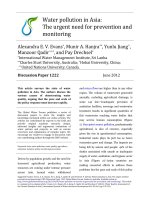- Trang chủ >>
- Khoa Học Tự Nhiên >>
- Vật lý
beyond war the human potential for peace feb 2007
Bạn đang xem bản rút gọn của tài liệu. Xem và tải ngay bản đầy đủ của tài liệu tại đây (13.53 MB, 352 trang )
Beyond
War
This page intentionally left blank
Beyond
War
The
Human
Potential
for
Peace
Douglas
P. Fry
OXFORD
UNIVERSITY
PRESS
2007
OXFORD
UNIVERSITY PRESS
Oxford University Press, Inc., publishes works that
further
Oxford University's objective
of
excellence
in
research, scholarship,
and
education.
Oxford
New
York
Auckland
Cape
Town
Dar es
Salaam
Hong
Kong Karachi
Kuala
Lumpur Madrid Melbourne Mexico
City
Nairobi
New
Delhi Shanghai Taipei
Toronto
With
offices
in
Argentina
Austria
Brazil
Chile
Czech
Republic France
Greece
Guatemala Hungary
Italy
Japan Poland Portugal Singapore
South Korea Switzerland Thailand
Turkey
Ukraine Vietnam
Copyright
©
2007
by
Douglas
P. Fry
Published
by
Oxford University Press, Inc.
198
Madison Avenue,
New
York,
NY
10016
www.oup.com
Oxford
is a
registered trademark
of
Oxford University Press
All
rights
reserved.
No
part
of
this publication
may be
reproduced,
stored
in a
retrieval system,
or
transmitted,
in any
form
or by any
means,
electronic, mechanical, photocopying, recording,
or
otherwise,
without
the
prior permission
of
Oxford University Press.
Library
of
Congress
Cataloging-in-Publication
Data
Fry,
Douglas
P.,
1953-
Beyond
war : the
human potential
for
peace
/ By
Douglas
P.
Fry.
p.
cm.
Includes bibliographical references
and
index.
ISBN
978-0-19-530948-5
1.
War.
2.
Warfare, Prehistoric.
3.
Peace—Social aspects.
4.
Ethnology.
5.
Conflict management—Social aspects.
I.
Title.
U21.2.F79
2007
303.6'6—dc22
2006023638
Printing
number:
987654321
Printed
in the
United States
of
America
on
acid-free
paper
To
Hanna, Heather, Jeremy,
Geoffrey,
Caroline,
Tyler,
Zachary, Kayla,
and
other
members
of
the
next generations
This page intentionally left blank
Contents
Foreword
by
Robert
M.
Sap
olsky
ix
Pre
face
xii
Acknowledgments
xvii
1
Charting
a New
Direction
1
2 Do
Nonwarring Societies Actually
Exist?
10
3
Overlooked
and
Underappreciated:
The
Human Potential
for
Peace
21
4
Killer
Apes, Cannibals,
and
Coprolites:
Projecting
Mayhem onto
the
Past
33
5 The
Earliest
Evidence
of War 50
6 War and
Social Organization: From Nomadic
Bands
to
Modern States
65
7
Seeking Justice:
The
Quest
for
Fairness
81
8 Man the
Warrior: Fact
or
Fantasy?
100
9
Insights
from
the
Outback: Geneva
Conventions
in the
Australian
Bush
113
10
Void
if
Detached
. . .
from
Reality:
Australian
"Warriors,"
Yanomamö
Unokais,
and
Lethal
Raiding
Psychology
131
viii Contents
11
Returning
to the
Evidence:
Life
in the
Band
148
12
Darwin
Got It
Right:
Sex
Differences
in
Aggression
166
13 A New
Evolutionary Perspective:
The
Nomadic Forager
Model
175
14
Setting
the
Record Straight
193
15 A
Macroscopic Anthropological View
201
16
Enhancing Peace
213
Appendix
1:
Organizations
to
Contact
235
Appendix
2:
Nonwarring
Societies
237
Notes
239
Suggested
Reading
322
Index
323
Foreword
People
often
get a bit
nutty when considering ideas about
the
"inevitability"
of
human behavior. Such notions come
in
many
forms.
For
example, there's
the
idea that
it is
preordained that
females
will
be
inferior
to
males
at
math.
Or
that certain genes
determine certain behaviors.
Or
that
it is
inevitable that
a guy
will
take
a
hostile view toward
his dad
having
a
penis.
Some
of the
time,
these
conclusions arise
from
confusing
correlation
with causality,
or
problems with discerning statistical
relationships,
or
failing
to
understand
the
idea
of
biological
vulnerability
and
interaction with
the
environment.
And
some
of
the
time,
they
are
just
plain
weird, complete with
fin-de-siècle
Viennese
froth.
I've
fallen
for
this
myself.
I've studied baboons
in
East
Africa
for
decades.
In the
process, I've gotten
to
know
my
nearest neighbors,
nomadic
pastoralist Masai tribespeople. Until
I had
kids
of my
own,
the
only ones
on
earth
I'd
been repeatedly exposed
to
were Masai
kids,
and my own
peers, growing
up in
Brooklyn.
And
based
on
that data set, here
is
something that
I
firmly
believe
is an
inevitable
human
behavior:
Once
a boy
discovers that
if
you
inflate
a
balloon
and let the air
out,
it
will
make
a
noise,
it
becomes universal
and
inevitable
that
he
will
do
this
by the
butt
of one of his
friends,
claim
that
said
friend
has
gas,
and get the
giggles.
So, as I
said, people
get a
little
nutty.
x
Foreword
One of the
truly well-entrenched realms
of
It-Is-Inevitable-That
is
that
it is
inevitable that humans
will
be
violent
and
that human
societies
will
wage
warfare.
Sometimes
a
view
like
this comes with
a
pretty
foul
agenda. Consider Konrad Lorenz, co-founder
of
ethology,
expert
on
bird behavior,
and
Nobel laureate.
In the
1960s,
in his
hugely
influential
book
OM
Aggression,
Lorenz
proclaimed
that human aggression
is
universal
and
inevitable.
The
stance
he
took makes considerable sense—Lorenz
was a
venomous
racist,
a man who
used
his
academic pulpit
in
Germany
to
write
Nazi propaganda poisonous enough
to
turn one's stomach,
a man
who
went
to his
death insisting that
he
spent
the
thousand-year
Reich
communing with
the
little birdies that
he
studied.
Don't
blame
people
if
they're
violent—they're just
following
their
inevitable
biological orders.
But
you
don't
have
to be
Lorenz
to
believe
in the
inevitability
of
human
violence. Anyone noticing
the
blood-drenched world
we
live
in
would have
to
take that idea seriously.
And
academics
of
various
stripes have
as
well.
Students
of
primatology
and
human evolution sure
thought
this.
The
1960s
saw the
rise
of the
Robert Ardrey/man-the-territorial-
hunter/big-cojones school
of
human evolution. Drawing upon
the
social
system
of the
savanna baboon
as a
surrogate
for our
formative
history
in the
savanna,
the
conclusion
was
that
we are by
nature
a
violent,
stratified,
male-dominated species. Jane Goodall's work
with chimps seemed
to
confirm
this
further,
demonstrating murder,
cannibalism,
organized group violence,
and
something resembling
genocide among
our
closest relatives.
The
game theorists were awash
in the
inevitability
of
violence
and
noncooperation
as
well.
The
heart
of
game theory,
the
Prisoner's
Dilemma game, repeatedly showed that
good
guys
Foreword
xi
finish
last,
that
the first
individual
who
spontaneously starts
cooperating
in the
game
is
competitively screwed
for the
rest
of
time,
as the
noncooperators snort derisively
at the
naivete.
Neuroendocrinologists weighed
in
also. Testosterone increases
aggression,
as it
increases
the
excitability
of
parts
of the
brain
relevant
to
aggression; girls inadvertently exposed
to
testosterone
prenatally
become more aggressive.
And,
naturally, none
of
this
is
true.
Even
those
violent chimps
and
baboons
can
reconcile
after
fights,
have cooperative, altruistic relationships,
can
even establish
and
transmit cultures
of low
aggression.
Then
there
are the
bonobo
chimps,
a
separate species that
is as
genetically related
to us as are
chimps,
a
species that
is
female-dominated,
has
remarkably
low
rates
of
aggression,
and
solves every conceivable social problem
with every conceivable
type
of
sex.
The
game theorists, meanwhile,
have spent recent years revealing
the
numerous circumstances that
select
for
cooperation rather than competition even
in
competitive
games
drenched
in
realpolitik.
And
normal levels
of
testosterone
turn
out not to
cause aggression
as
much
as
exaggerate preexisting
social
tendencies toward aggression; without
the
latter, testosterone
doesn't remotely translate into inevitable aggression.
In
this superb book, Douglas
Fry
gives
lie to the
inevitability
o
f
violence
by
surveying another
set of
disciplines, namely, cultural
anthropology, archaeology,
and
human paleontology.
He
trashes
the
urban myth
of
inevitable aggression
in
numerous ways.
These
include
documenting
the
varied human cultures with
minimal
or
no
intra-
or
intergroup violence, exploring
the
social systems
and
ecosystems that predispose toward cultures without
warfare
and
their social mechanisms
for
sidestepping group violence, revealing
the
mistakes
in
classifications
that have given rise
to
erroneous
xii
Foreword
labeling
of
certain
societies
as
warlike.
The
book
also reveals
other
mistakes
that
infest
this literature:
A
virtuosic chapter analyzes
the
fatal
flaws in a
famed,
canonical study that seemingly displays
the
reproductive, evolutionary
benefits
of
murder
in an
indigenous
society.
All
this
is
done
in a way
that
is
encyclopedic
and
authoritative.
And
well-written,
and
often moving,
and
surprisingly often—given
such
an
intrinsically
dour subject—funny.
It
seems inevitable
at
this
point
in a
foreword
to
list
the
sorts
of
people
who
should read this
book—jurists,
legislators, parents, butchers, bakers
. . .
Instead,
I
will
avoid another supposed inevitability
and
simply
say
this
book
should
be
read.
It is
important.
Robert
M.
Sapolsky
Preface
When
I first
began studying anthropology,
one
aspect
of the
discipline
that appealed
to me was its
breadth. Where
do we
come
from?
What
is our
nature? What does
it
mean
to be
human?
Why
do we
behave
the way we do?
What
are the
prospects
for our
future?
Anthropology addresses
big
questions.
Literally
the
"study
of
humankind,"
anthropology lends
itself
to a
macroscopic
perspective.
It
focuses
not
just
on the
present,
but
also
on the
past.
It
seeks
to
understand specific cultures
as
well
as
recurring patterns that span
societies.
Anthropology simultaneously embraces
the
biosocial
diversity
and
uniformity
of
humanity.
There
is a
natural tendency
to
think
in
terms
of the
here
and
now of
everyday
life.
But as we
enter
the
twenty-first century, many
of
the
challenges
facing
humanity demand
a
broader context.
The
macroscopic perspective
of
anthropology, with
its
expansive
time
frame
and
culturally comparative orientation,
can
provide
unique
insights into
the
nature
of war and the
potential
for
peace.
A
cross-cultural perspective shows,
for
instance, that humans
everywhere seek justice—although
the
paths
to
justice vary.
Some entail violence
but
others
do
not. Much violence,
in
fact,
stems
from
people defending their rights
or
attempting
to
correct
injustices.
Anthropological
and
historical cases show that
it
is
possible
to
replace violent means
of
justice seeking with
nonviolent
approaches. Herein lies
a
broader lesson
for
creating
and
maintaining
peace.
xiv
Preface
A
macroscopic anthropological view suggests that
it
would
be
possible
to
replace
the
institution
of war
with
more
effective,
less
brutal
ways
of
seeking security, defending rights,
and
providing
justice
for the
people
of
this planet.
In an era of
nuclear
missiles
and
other weapons
of
mass destruction, trying
to
achieve security
through
the
threat
or use of
military
force
is
like
trying
to
perform
heart
surgery
with
a
chain saw.
For the
good
of us
all,
we
must
replace
the war
system with viable
institutions
for
creating peace,
delivering
justice,
and
guaranteeing security.
In
adopting
a
view that spans
millennia
and
crosses cultural
space,
I
draw
on
data
from
many anthropological
fields:
archaeology,
hunter-gatherer
research,
ethnographic descriptions
of
particular
societies,
comparative cross-cultural studies, research
on
cultural
belief
systems,
and
applied anthropology
(a field
that
focuses
on
real-world problem solving).
The
book
also includes
theory
and
data
from
fields
beyond anthropology,
for
example, behavioral
ecology, game theory,
animal
behavior,
and
evolutionary biology.
The
goal
is to
attain
a
view
of the
human capacities
for
violence
and
peace that
is as
complete
and
integrated
as
possible.
In
my
experience, some people,
accustomed
to the
international
war
system, assume that
it
simply
is not
possible
to find
better ways
to
resolve
differences
and to
assure security. However,
the
wealth
of
anthropological data considered
in
this book suggests otherwise.
Humans
have
a
tremendous capacity
for
resolving
conflicts
without
violence.
In
today's world,
we
need
to
apply
these
skills
in new
ways
and on a
grander scale.
We
need
to
think
in
new, bolder ways about
creating realistic alternatives
to
war.
Too
often,
short-term, shallo
security analyses prevail over more comprehensive planning
for a
secure
future.
Rather than
focusing
exclusively
on
narrow issues,
such
as how
many
fighter
jets
to
order
this year
or
what
to do
about
Preface
xv
the
local "hot spots" most likely
to
erupt into violence this month,
we
need
to
address
a set of
broader,
critically important questions
that
are
centrally relevant
to
providing genuine, long-term
safety
and
security
for the
people
of the
planet.
How can we
improve
the
quality
of
life
for all
humanity,
reduce
the
social
and
economic
inequalities
that
foment
hostility, hatred,
and
terrorism,
and
create
new
procedures
and
institutions
for
providing justice
and
resolving
differences
without war?
In
short,
at the
global level,
how can we
replace
the law of
force
with
the
force
of
law?
A
central goal
of
this
book
is to
thoroughly explore
how
anthropology contributes
to
understanding
war and
peace.
I
hope
to
challenge existing ways
of
thinking about war, peace, security,
and
justice.
These
are
topics that concern each
and
every
one of
us
on
this interdependent planet where
we all
breathe
the
same
air
and
would perish
together
in the
same nuclear winter.
By
questioning
traditional thinking,
I
hope that
the
book
will
promote
reflection,
discussion,
and
action
for a
safer
world.
Helsinki, Finland
June
8,
2006
This page intentionally left blank
Acknowledgments
As
I've worked
on
this book
and its
predecessor,
The
Human
Potential
for
Peace,
many
friends
and
colleagues graciously have engaged
in
discussions
on
relevant topics, provided bibliographic
information
or
other
forms
of
help, supplied photographs,
or
read
and
commented
on
draft
chapters.
I
warmly thank John Archer, Roger
Archer, Ofer
Bar-Yosef,
Jan
Beatty, Megan
Biesele,
Kaj
Björkqvist,
Chris
Boehm, Bruce Bonta, James
Cote,
Mark Davis, Frans
de
Waal,
Bob
Dentan, Carol Ember,
Mel
Ember, Kirk Endicott,
R.
Brian
Ferguson,
Tim
Finan,
C.
Brooks Fry, Kathy Fry, Sirpa Fry, Agustin
Fuentes,
Peter Gardner,
Tom
Gregor, Jonathan Haas, Marvin
Harris, Robert Hinde,
Bob
Hitchcock,
Paul
L.
Jamison,
Allen
Johnson, Terttu Kaivola, Talia Krohn,
Ray
Kelly,
Sue
Kent, Hanna
Korpela,
Mari Laaksonen, Catherine Lutz, Katie MacKinnon,
Joyce Marcus, Peter Meylan, Carolyn Nordstrom, Carl
O'Nell,
Karin
Osterman, John Paddock, Fred
Rawski,
Carole Robarchek,
Clay
Robarchek, Nancy Ries, Maria Rodriguez, Heikki Sarmaja,
Cliff
Sather, Kenneth
Smail,
Peter
K.
Smith,
Les
Sponsel, Jukka-
Pekka
Takala,
Cybele
Tom,
Bob
Tonkinson,
Jim
Welch,
and
Camilla
Westermark.
1
very much appreciate
the
guidance
of the
editorial team
at
Oxford University Press.
I
thank
Jan
Beatty
for
recommending
the
proposal
to her
colleagues, Elda Rotor
for
helping
to
shape
the
project into
its
current
form,
and
especially
Cybele
Tom for
providing
truly excellent suggestions.
I
gratefully
acknowledge
xviii
Acknowledgments
Cybele's critical role
in
shaping
the
content
and
presentation,
fine
tuning
the
arguments,
and
enhancing
the
readability
of the
book.
I
also thank
Lelia
Mander
for so
capably overseeing production
and
Sue
Warga
for
splendid copyediting.
Material
in
this book
was
collected during research projects
supported
by the
United States Institute
of
Peace (grant number
023-99F),
the
National Science Foundation (grant numbers
81-
17478,
97-10071,
and
03-13670),
the
Wenner-Gren
Foundation
for
Anthropological Research (grant number
4117),
and an
Indiana
University
Skomp
Fellowship (number 26-235-77).
I am
very
grateful
to
these institutions
for
supporting
my
research
on
huma
aggression
and
conflict
resolution over
the
years.
It
should also
be
clear that
the
opinions expressed
in
this
book
do not
necessarily
reflect
the
views
of
these granting agencies.
I
owe
warm thanks
to my
wife,
Sirpa
Fry,
and my
father,
Brooks
Fry,
for
their unfaltering support during
the
entire writing project.
Sirpa
has
heard—repeatedly,
I'm
afraid—about
the
trials
and
tribulations
of
working
on a
project
of
this nature.
She
always
has
offered
sound, supportive advice
and
honest,
helpful
reactions
to
my
prose,
for
which
I
remain most
grateful.
Beyond
War
This page intentionally left blank
1
Charting
a New
Direction
Many
ideas
in
science
seemed
crazy
at one
time
but are now
regarded
as
being
settled,
either
having
been
laid
to
rest
(as in the
case
of
cold
fusion)
or
firmly
established
(as
in the
case
of
plate tectonics,
which
grew
out of an
earlier
"crazy"
theory
of
continental
drift).
. . .
But,
even
the
weirdest theories
of
science
must
pass
one
rigorou
test
or be
discarded: their predictions
must
be in
agreement
with
phenomena observed
in
the
physical
world.
—ROBERT
EHRLICH,
NINE
CRAZY
IDEAS
IN
SCIENCE
This
book
takes
the
road
less
traveled.
It
examines
how
cultural
beliefs
about
war
bias
scientific
interpretations,
affect
perceptions
of
human nature,
and may
even close
our
minds
to the
possibility
of
developing alternatives
to
armed
conflict.
The
book
reexamines
existing interpretations against
the
actual evidence
in an
attempt
to
untangle
fact
from
fantasy.
As we
will
discover,
there
is a lot
of
fantasy floating
around
out
there.
A
thorough
review
of the
evidence leads,
first, to a
critique
of the
status
quo
picture
of war
and
human
nature—here
dubbed
the
"man
the
warrior" perspective
—and,
second,
to the
construction
of a new
interpretation
of
human aggression.
The
book
argues that
warfare
is not
inevitable
2
Beyond
War
and
that humans have
a
substantial capacity
for
dealing with
conflicts
nonviolently.
There
are
ways
to
move
beyond
war.
A
sleuthing analogy
may
help
to
clarify
what this book
is all
about. Imagine that Holmes
and
Watson don't know
the sex of a
person
who has
just moved into their neighborhood,
but
they
have
heard
that
the new
neighbor lives alone. Walking
by the
house
on
Saturday
afternoon,
they observe
the
following
clues.
The
name
on the
mailbox
is
Tyler Geoffrey.
The
pickup truck parked
in
front
of the
house
has a
somewhat sexist bumper sticker
that,
in
advertising Carol's Pizzeria, attempts
to
humorously equate
women with pizza. Glancing
in the
side window
of the
truck,
Holmes astutely observes that
the
driver's seat
is
adjusted
far
back
from
the
steering wheel.
Based
on
these
facts,
the
obvious
conclusion
is
that
the new
neighbor
is a
man.
It
seems crazy
to
argue that
a
tall,
pickup-driving, sexist person named Tyler might
be a
woman.
According
to the
"man
the
warrior" view, humans (especially
males)
are
warlike
by
nature. Advocates
of
this perspective forge
a
tight
evolutionary link
between
chimpanzee
and
human violence,
emphasize
sex
differences
in
aggression,
and
recite
a
litany
of
barbarity, atrocity,
and
brutality
to
support this portrait
of
humanity.
The
validity
of
this "man
the
warrior" view
may
seem
rather
obvious/
after
all,
we all
know that humans make
war and
that wars always seem
to be
raging somewhere. However,
a
different—but
not
polar
opposite—perspective
will
be
suggested
in
this
book.
According
to
this
new
view, clearly humans
are
capable
of
creating great mayhem,
but
they
also have
a
remarkable capacity
for
working
out
conflicts
without
resorting
to
violence. Specifically,
a
careful
reexamination
of the
actual evidence
will
lead
us to the
conclusion
that humans
are not
warlike
by
nature.
Charting
a New
Direction
3
If
this sounds improbable
to
some readers,
I
must
beg for
indulgence
and ask
that
we
suspend
judgment
until
we
examine
the
evidence
and
arguments. Data
from
a
vast array
of
archaeological
and
ethnographic research
will
give
us a
comprehensive picture
that leads
to new
interpretations. This view
is
broader,
by
far, than
merely looking
at
current
political
events
or
using data
from
a
single
academic
field,
culture,
or
time period.
To
express
the
challenge
in
terms
of our
sleuthing analogy,
how
solid
is the
seemingly obvious conclusion that Holmes
and
Watson's
new
neighbor
is a
man?
Bear
in
mind that
our
sleuths
haven't actually seen
the
person.
We can
begin
to
question
assumptions.
What
if
Tyler
Geoffrey
was the
previous resident's
name?
What
if
Tyler
in
this case actually
is the
name
of a
woman?
What
if the
pickup truck belongs
to
someone else?
Or,
assuming
that
the
truck
in
fact
does
belong
to the new
neighbor, aren't some
women
tall?
And
don't some women drive pickup trucks?
It is
even
possible,
although perhaps
not
probable, that
a
woman could
own
a
truck displaying
a
bumper sticker that most women would shun.
What
if she
borrowed
the
truck
from
a
male
friend
for
moving?
The
main
point
is
that
the
initial
"obvious" conclusion rests
on a set of
assumptions
and may be
absolutely wrong.
Similarly,
I
propose that
the
evidence supporting
the
"man
the
warrior"
view
of
humanity
is in
fact
very limited. And,
as
unlikely
as
it
might sound
at first,
most
of the
assumptions
of
this neo-
Hobbesian view
are
simply
flawed. The way to
evaluate this issue
is
to
look
carefully
at the
evidence
and the
arguments.
Holmes
and
Watson realize that
if
they really want
to be
sure
that their
new
neighbor
is a
man,
they
should look
for
more clues.
Watson proposes that
they
knock
on the
door
to
say, "Welcome
to
the
neighborhood." Unfortunately,
no one
responds,
but
while
4
Beyond
War
they
are
waiting, Holmes surveys
the
interior
of the
house through
an
adjacent
front
window. Watson knocks
a
second time
and
looks
displeased,
noticing that Holmes
is not so
subtly peering through
the
window.
Holmes
has
noticed
a
small
table near
the
front
door
and
partly
under
the
front
window. Holmes also
can see
across
the
living
room
to a
bar-height kitchen counter.
On the
table near
the
front
door
Holmes notes
a
hairbrush with long dark
hairs,
a
makeup kit,
and
a
key
ring containing
five
keys
and a
small plastic
figure of
Snoopy.
Scattered
on the
living
room
sofa,
which
faces
the
window, Holmes
spies
a
violet sweater,
the
unread daily newspaper,
a
cookbook,
and two
magazines—Better
Homes
and
Gardens
and an
issue
of
Glamour
with
model Heather Graham
on the
cover.
The
room
has
various
cardboard
moving boxes, some open, some sealed.
A
signed
photograph
of
actor Jeremy
Irons
protrudes
from
one of
them.
Looking
across
the
living
room, Holmes scans
a
miscellaneous
assortment
of
small
items
on the
kitchen counter.
One
item
in
particular
catches Holmes' attention,
a
plastic
bottle brightly
labeled
"Multivitamins
plus Iron."
In
light
of
this more extensive investigation, Holmes
and
Watson
are
ready
to
modify
their
initial
conclusion.
They
still
have
not
been able
to
gather
all of the
information
they hoped
for—
meeting
the new
neighbor
face-to-face—but
they
have been able
to
collect many
new
clues
by
looking
in the
window. Moreover,
they
have weighed
the
importance
of
different
types
of
information
in
their minds
to
arrive
at a
comprehensive judgment.
Watson
remarks
to
Holmes
as
they continue their
walk,
"I've seen more
women
driving pickup trucks than
single
men's homes with
stuff
like
that." Holmes replies, "Precisely, Watson.
And
also consider
what
paraphernalia
were
not
there."









